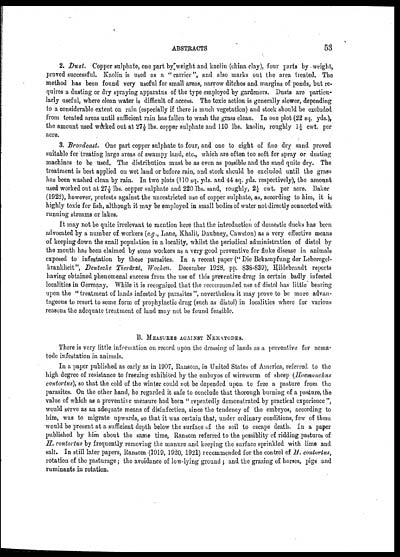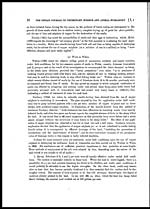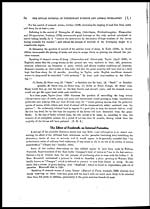Medicine - Veterinary > Veterinary colleges and laboratories > Indian journal of veterinary science and animal husbandry > Volume 1, 1931 > Part I (March 1931) > Abstracts
(87) Page 53
Download files
Individual page:
Thumbnail gallery: Grid view | List view

ABSTRACTS 53
2. Dust. Copper sulphate, one part by weight and kaolin (china clay), four parts by weight,
proved successful. Kaolin is used as a " carrier ", and also marks out the area treated. The
method has been found very useful for small areas, narrow ditches and margins of ponds, but re-
quires a dusting or dry spraying apparatus of the type employed by gardeners. Dusts are particu-
larly useful, where clean water is difficult of access. The toxic action is generally slower, depending
to a considerable extent on rain (especially if there is much vegetation) and stock should be excluded
from treated areas until sufficient rain has fallen to wash the grass clean. In one plot (22 sq. yds.),
the amount used worked out at 27½ lbs. copper sulphate and 110 lbs. kaolin, roughly 1¼ cwt. per
acre.
3. Broadcast. One part copper sulphate to four, and one to eight of fine dry sand proved
suitable for treating large areas of swampy land, etc., which are often too soft for spray or dusting
machines to be used. The distribution must be as even as possible and the sand quite dry. The
treatment is best applied on wet land or before rain, and stock should be excluded until the grass
has been washed clean by rain. In two plots (110 sq. yds. and 44 sq. yds. respectively), the amount
used worked out at 27½ lbs. copper sulphate and 220 lbs. sand, roughly, 2¼ cwt. per acre. Baker
(1922), however, protests against the unrestricted use of copper sulphate, as, according to him, it is
highly toxic for fish, although it may be employed in small bodies of water not directly connected with
running streams or lakes.
It may not be quite irrelevant to mention here that the introduction of domestic ducks has been
advocated by a number of workers (e.g., Lane, Khalil, Daubney, Cawston) as a very effective means
of keeping down the snail population in a locality, whilst the periodical administration of distol by
the mouth has been claimed by some workers as a very good preventive for fluke disease in animals
exposed to infestation by these parasites. In a recent paper (" Die Bekampfung der Leberegel-
krankheit", Deutsche Tierärzt. Wochen. December 1928, pp. 838-839), Hildebrandt reports
having obtained phenomenal success from the use of this preventive drug in certain badly infested
localities in Germany. While it is recognized that the recommended use of distol has little bearing
upon the " treatment of lands infested by parasites ", nevertheless it may prove to be more advan-
tageous to resort to some form of prophylactic drug (such as distol) in localities where for various
reasons the adequate treatment of land may not be found feasible.
B. MEASURES AGAINST NEMATODES.
There is very little information on record upon the dressing of lands as a preventive for nema-
tode infestation in animals.
In a paper published as early as in 1907, Ransom, in United States of America, referred to the
high degree of resistance to freezing exhibited by the embryos of wireworm of sheep (Haemonchus
contortus), so that the cold of the winter could not be depended upon to free a pasture from the
parasites. On the other hand, he regarded it safe to conclude that thorough burning of a pasture, the
value of which as a preventive measure had been " repeatedly demonstrated by practical experience ",
would serve as an adequate means of disinfection, since the tendency of the embryos, according to
him, was to migrate upwards, so that it was certain that, under ordinary conditions, few of them
would be present at a sufficient depth below the surface of the soil to escape death. In a paper
published by him about the same time, Ransom referred to the possiblity of ridding pastures of
H. contortus by frequently removing the manure and keeping the surface sprinkled with lime and
salt. In still later papers, Ransom (1919, 1920, 1921) recommended for the control of H. contortus,
rotation of the pasturage ; the avoidance of low-lying ground ; and the grazing of horses, pigs and
ruminants in rotation.
Set display mode to: Large image | Zoom image | Transcription
Images and transcriptions on this page, including medium image downloads, may be used under the Creative Commons Attribution 4.0 International Licence unless otherwise stated. ![]()
| Permanent URL | https://digital.nls.uk/75226055 |
|---|
| Description | Covers articles from 1931. |
|---|




